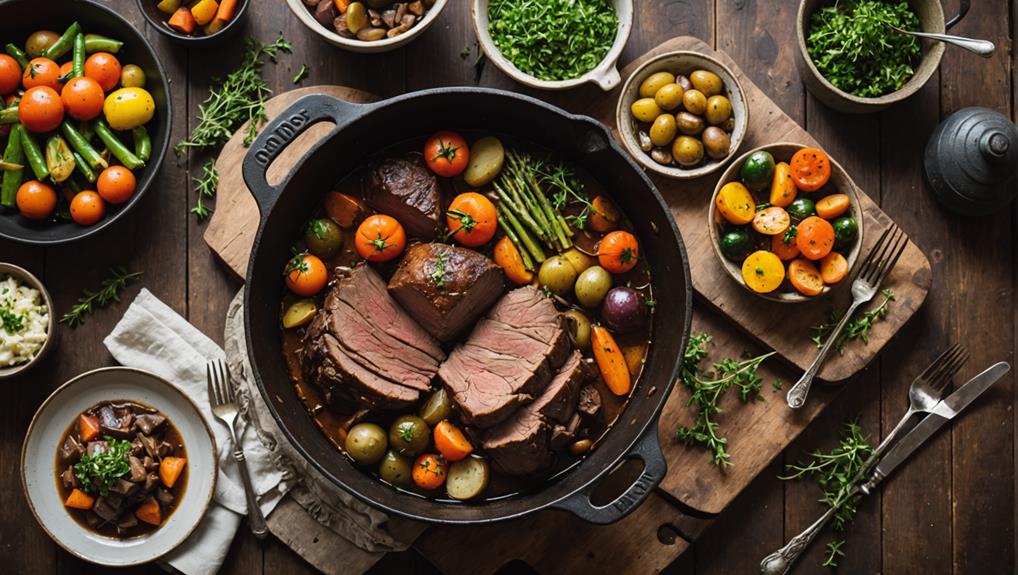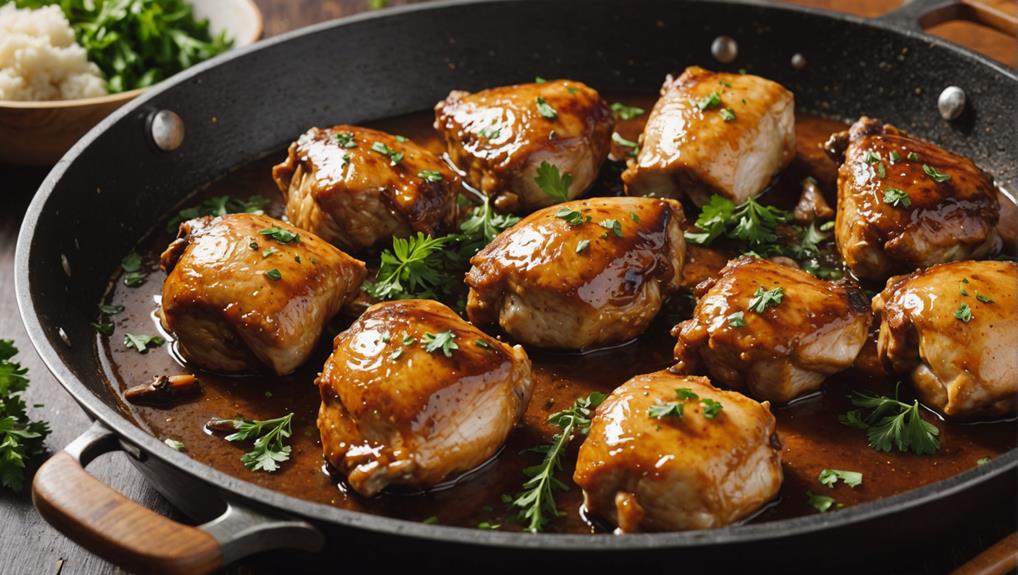Mastering braising and roasting can transform your culinary skills, elevating your dishes to new heights. Braising combines dry and moist heat, ideal for tough cuts, while roasting uses dry heat for tender meats. You'll learn to create deep, complex flavors through braising's low-and-slow method, perfect for hearty meals. Roasting, on the other hand, enhances natural flavors and achieves a crispy exterior. Temperature control is crucial: maintain 275-300°F for braising and 325-450°F for roasting. Choose braising for special occasions and tough cuts, and roasting for quick, impressive meals. With the right techniques and equipment, you'll master both methods and unlock a world of culinary possibilities.
Unveiling Braising and Roasting
Unveiling the differences between braising and roasting can help you elevate your cooking game. These two techniques, while both transformative, serve distinct culinary purposes.
Braising, a slow-cooking method, combines dry and moist heat to create tender, flavor-rich dishes. You'll start by searing the meat at high temperatures, then cook it partially submerged in liquid at lower temperatures (275°F to 300°F). This process breaks down collagen in tougher cuts, resulting in melt-in-your-mouth textures. A great example of this is Braised Short Ribs in Red Wine, where slow cooking yields tender meat and a rich sauce, enhancing the overall flavor.
Roasting, on the other hand, is a dry-heat method that operates at higher temperatures (325°F to 450°F). It's ideal for tender cuts of meat, creating a crispy exterior while maintaining internal juiciness. You'll cook food uncovered, allowing it to develop a caramelized texture quickly. This method excels with prime rib or whole poultry, enhancing natural flavors through rapid cooking.
Both techniques offer unique advantages depending on your desired outcome. Braising yields rich, complex flavors and fall-apart tenderness, perfect for tougher cuts. Roasting emphasizes efficiency and crispy textures, ideal for showcasing the inherent qualities of premium meats.
Mastering the Cooking Methods
Dive into mastering the art of braising and roasting to elevate your culinary skills. These two cooking methods offer distinct approaches to transforming meats into mouthwatering dishes.
When braising, you'll start by searing tougher cuts at high heat, then slow-cook them partially submerged in liquid at 275°F to 300°F. This process breaks down collagen into gelatin, resulting in tender, flavor-packed meals perfect for hearty fare.
Roasting, on the other hand, utilizes dry heat at temperatures between 325°F and 450°F. This technique creates a crisp exterior while enhancing the natural flavors of more tender cuts. The high-temperature process allows for caramelization, yielding a well-browned crust and juicy interior without added moisture.
To master these cooking methods, it's crucial to understand the appropriate techniques and temperature ranges for each. Braising excels at developing rich, deep flavors through prolonged cooking, while roasting achieves a delectable balance of texture and taste.
Flavor Profile Showdown
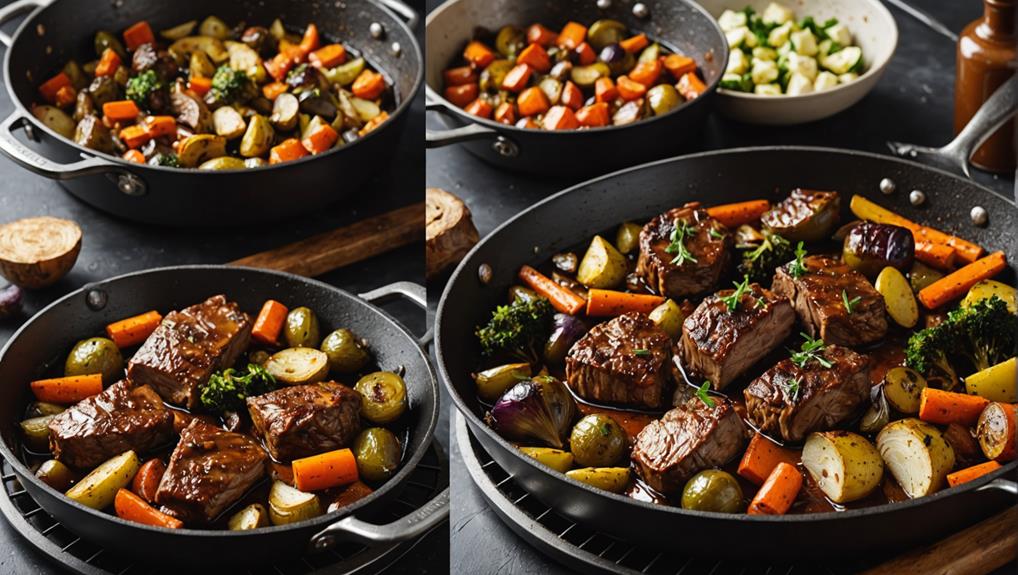
Through the lens of flavor, braising and roasting offer distinct profiles that cater to different culinary preferences. Braising, with its low-and-slow cooking process, transforms tough cuts into tender, flavor-packed morsels.
As you simmer your ingredients in a small amount of liquid at 275°F to 300°F, you'll unlock rich, deep flavors that permeate the entire dish. This method is particularly effective for dishes like hearty beef stew, where the combination of searing and slow simmering melds diverse flavors beautifully.
Spices and aromatics infuse the meat, creating a melt-in-your-mouth experience that's hard to resist.
Roasting, on the other hand, is your go-to method for enhancing natural flavors without added moisture. By exposing ingredients to high temperatures between 325°F and 450°F, you'll achieve a crispy exterior that locks in juices and intensifies taste.
This cooking process excels at caramelizing surfaces, giving you that sought-after golden-brown finish.
When deciding between these techniques, consider your desired outcome. Opt for braising when you want a moist, deeply flavored dish that's perfect for cooler months.
Choose roasting when you're after a quick, crispy result that showcases the ingredient's inherent taste.
Both methods will elevate your culinary game, offering unique ways to transform ingredients into delectable masterpieces.
Texture and Tenderness Comparison
Texture and tenderness are key factors that distinguish braising from roasting. When you're aiming for melt-in-your-mouth tenderness, braising is your go-to technique. This method transforms tough cuts into succulent masterpieces by cooking them low and slow, typically between 275°F and 300°F. The moist heat breaks down collagen, resulting in an incredibly tender texture that'll wow your dinner guests.
Roasting, on the other hand, is perfect for tender cuts. You'll achieve a crispy exterior while maintaining a juicy interior by cooking uncovered at higher temperatures, usually 325°F to 450°F. But be cautious – extended roasting can lead to moisture loss and toughness if you're not careful with temperature control.
For maximum tenderness in braised dishes, aim for temperatures exceeding 210°F. This promotes significant collagen conversion into gelatin, enhancing the meat's texture.
With roasting, you'll want to hit the sweet spot temperature for your specific cut to avoid toughness. Remember, braising yields rich, moist results ideal for hearty dishes, while roasting emphasizes quick cooking for that desirable crispy finish you crave.
Temperature and Time Management
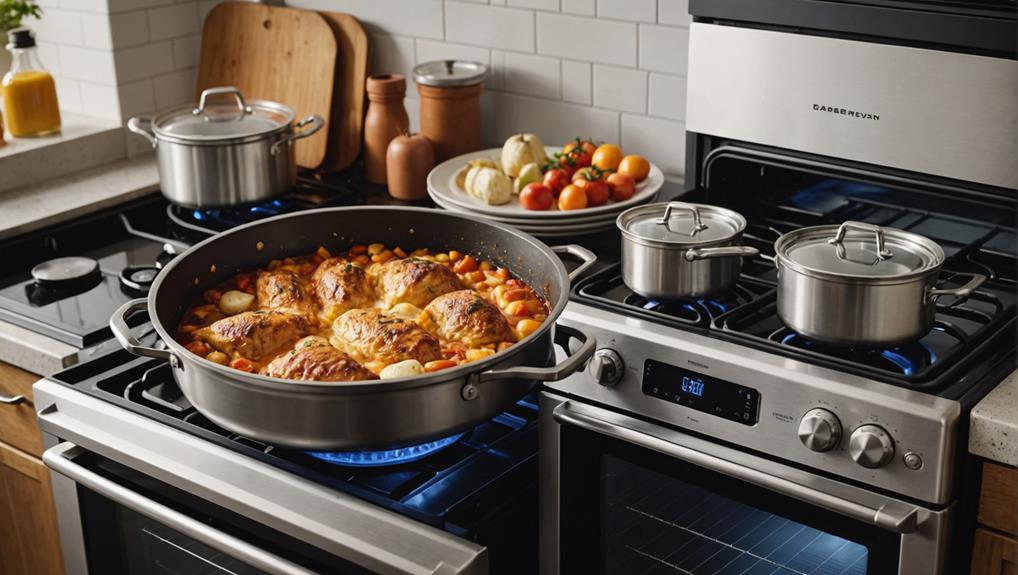
When managing temperature and time for braising and roasting, you'll need to understand the optimal cooking temperatures for each method. For braising, you'll want to maintain lower temperatures between 275°F and 300°F, while roasting requires higher heat ranging from 325°F to 450°F.
You'll also need to develop effective time management strategies, as braising typically demands 2 to 5 hours of cooking time, whereas roasting often takes less than 2 hours.
To ensure success, it's crucial to employ temperature monitoring techniques, such as using a meat thermometer to check internal temperatures and adjusting cooking times accordingly.
Optimal Cooking Temperatures
Temperature control is the key to mastering both braising and roasting techniques. When you're aiming for tender meat, understanding optimal cooking temperatures is crucial.
For braising, you'll want to keep your oven between 275°F and 300°F. This low, slow heat allows tough cuts to transform into succulent, fall-off-the-bone delicacies. The magic happens as collagen breaks down, but remember, you need to maintain at least 200°F for this process to occur effectively.
Roasting, on the other hand, demands higher temperatures. Set your oven between 325°F and 450°F to achieve that perfect balance of crispy exterior and juicy interior. This method works wonders for tender cuts, creating a delectable crust while preserving moisture.
Time management is equally important. Braising requires patience, often taking several hours to reach peak flavor and tenderness.
Roasting is generally quicker, giving you that crisp finish in less time. To innovate your cooking, invest in a reliable meat thermometer. For braised dishes, maintain a consistent low heat to prevent drying out.
When roasting, monitor internal temperatures to hit your target doneness without overcooking.
Time Management Strategies
Mastering time management is the secret ingredient in perfecting both braising and roasting techniques. To revolutionize your culinary skills, consider these innovative strategies:
1. Plan ahead: For braising, allocate several hours to overnight for optimal tenderness. Roasting demands 1-3 hours, depending on the cut.
Chicken Pot Pie is another great dish that benefits from careful planning and timing to ensure all ingredients meld perfectly.
2. Use a reliable meat thermometer: Track internal temperatures to achieve perfection. Aim for 190°F to 210°F for braised meats, and 165°F for poultry or 145°F for red meat when roasting.
3. Implement a cooking schedule: Start braising early in the day or even the night before for maximum flavor development. Time roasts to finish just before serving for optimal texture.
4. Embrace technology: Utilize smart kitchen devices or apps to set timers and reminders, ensuring you don't lose track of cooking progress.
Temperature Monitoring Techniques
Three essential temperature monitoring techniques can elevate your braising and roasting game.
First, invest in a high-quality digital meat thermometer. This innovative tool provides precise readings, allowing you to achieve the perfect internal temperature for your meat. For braising, aim for 275°F to 300°F, while roasting requires 325°F to 450°F.
Second, master the art of maintaining steady temperatures. During braising, you'll need to keep the heat consistent for hours to break down tough connective tissue effectively. Roasting, on the other hand, demands more frequent checks to prevent overheating.
Finally, harness the power of technology. Use a convection oven for roasting to enhance heat distribution and reduce cooking time. For braising, employ foiling or water pans to retain moisture.
Remember, timing is crucial. Braising often requires several hours, while roasting times vary based on the cut and temperature. By implementing these temperature monitoring techniques, you'll transform your cooking process, ensuring tender, juicy results every time.
Whether you're breaking down tough cuts through braising or creating a crispy exterior through roasting, precise temperature control is your key to culinary success.
Choosing the Perfect Dish
When choosing between braising and roasting for your dish, consider the cut of meat you're working with and your desired flavor profile.
You'll want to match tough cuts with braising for tender, flavorful results, while tender cuts are perfect for roasting to achieve a crispy exterior and juicy interior.
Your available time and the occasion also play a role in your decision, as roasting is generally quicker and well-suited for weekday meals, while braising's longer cooking time might be better for special occasions or weekend cooking.
Matching Cuts to Method
Before diving into a recipe, it's crucial to match your cut of meat with the right cooking method. Your choice between braising and roasting can make or break your dish, so let's explore how to pair cuts with techniques for optimal results.
When selecting your cooking approach, consider these factors:
- Meat tenderness
- Desired flavor profile
- Available cooking time
- Preferred texture outcome
For tougher cuts like chuck roast or brisket, braising is your go-to method. This slow-cooking technique breaks down connective tissue, resulting in tender, flavorful meat.
You'll want to set your oven between 275°F and 300°F for best results. The added bonus? Your meat will absorb flavors from the cooking liquid and aromatics, creating a depth of flavor that's hard to beat.
On the flip side, tender cuts like prime rib or chicken thrive with roasting. This high-temperature method (325°F to 450°F) creates a crispy exterior while maintaining a juicy interior.
Roasting emphasizes the meat's natural flavors, perfect for those who prefer a pure, unadulterated taste.
Flavor Profile Preferences
In light of your flavor preferences, choosing between braising and roasting can significantly impact your dining experience. When you're craving rich, deep flavors that envelop your palate, braising is your go-to method. It's perfect for transforming tougher cuts of meat into melt-in-your-mouth delicacies, ideal for those cozy, comfort food moments.
On the other hand, if you're after a dish that celebrates the natural flavors of tender cuts while providing a satisfying crispy exterior, roasting is your best bet.
Consider your desired flavor profile and time constraints when making your choice. Braising excels in developing complex flavors through low and slow cooking, breaking down connective tissues to achieve ultimate tenderness. It's the perfect technique for hearty, cold-weather meals that warm you from the inside out.
Roasting, however, offers a quicker solution without compromising on flavor. It's ideal when you want to enhance the meat's natural taste while achieving a delightful caramelized crust. Ultimately, your selection between braising and roasting hinges on your flavor preferences and the specific cuts of meat you're working with.
Time and Occasion
Considering the occasion and time available, your choice between braising and roasting can make or break your culinary efforts.
For cozy family gatherings or winter meals, braising's slow-cooked flavors and tender textures create hearty dishes that warm the soul. On the other hand, roasting shines during celebratory events, delivering impressive presentations with crisp exteriors and enhanced natural flavors.
Time plays a crucial role in your decision. Braising requires several hours for optimal flavor development, while roasting offers quicker results.
To choose the perfect cooking method, consider these factors:
- Available time
- Desired texture (moist and rich vs. crisp and caramelized)
- Type of meat (tough cuts for braising, tender cuts for roasting)
- Occasion (comfort food vs. celebratory meals)
For economical cooking, braising transforms tougher cuts into succulent dishes. However, if you're working with tender cuts and aiming for maximum flavor in less time, roasting is your go-to method.
Kitchen Techniques for Every Cook
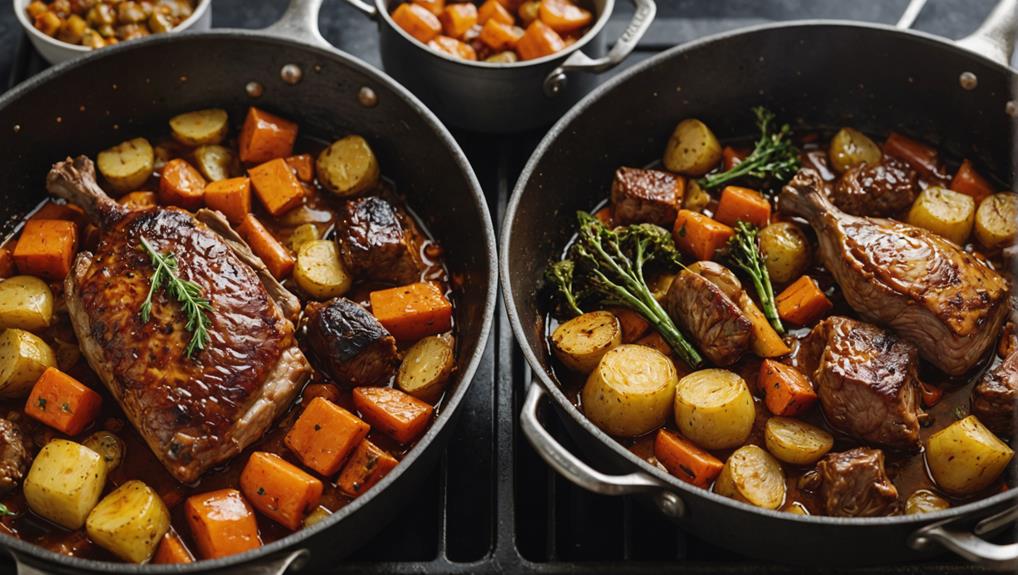
When it comes to kitchen techniques, mastering the art of braising and roasting can elevate your cooking game significantly. These processes offer unique approaches to transforming tough cuts into tender delights or creating crispy exteriors with juicy interiors. To become a culinary innovator, you'll need to understand the science behind each method.
For braising, start by searing your meat at high temperatures to lock in flavors. Then, partially submerge it in liquid and cook slowly at 275°F to 300°F. This process breaks down collagen, resulting in fork-tender meat perfect for hearty dishes.
Roasting, on the other hand, uses dry heat at 325°F to 450°F to enhance natural flavors without added moisture. It's ideal for more tender cuts, creating a crispy exterior while maintaining juiciness inside.
To achieve optimal results, you'll need to experiment with moisture management and temperature control. Pay attention to meat composition and adjust your technique accordingly.
Equipment and Tools Overview
Equipping your kitchen with the right tools is essential for successful braising and roasting. When it comes to these transformative cooking methods, your choice of equipment can make or break the end result.
For braising, you'll want heavy, tight-fitting pots like Dutch ovens that retain moisture and heat, ensuring your meat cuts become tender throughout the process. Roasting, on the other hand, calls for sturdy pans that promote even heat circulation and browning.
To elevate your culinary game, consider these innovative tools:
- Digital meat thermometer for precise temperature control
- Adjustable-height roasting rack for optimal air circulation
- Silicone basting brush for even sauce application
- Multi-functional braising pan with stovetop-to-oven capability
As you embark on your flavor transformation journey, remember that the process begins with the right equipment. Invest in a reliable oven thermometer to maintain consistent temperatures, and don't overlook the importance of a good baster or ladle for braising.
For roasting, a spray bottle can be a game-changer for applying sauces evenly. By mastering these tools, you'll unlock new levels of culinary creativity and achieve restaurant-quality results in your own kitchen.
Culinary Tips and Tricks
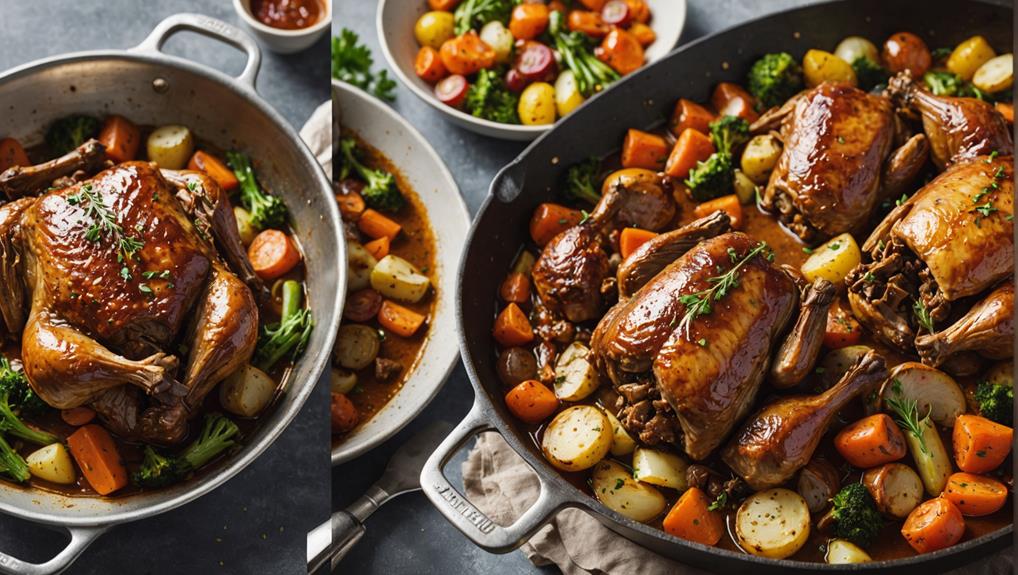
Let's dive into some culinary tips and tricks that'll elevate your braising and roasting game.
To better understand these techniques, focus on matching the right method to your cut of meat. For tougher cuts, braising is your go-to, combining dry and moist heat to break down collagen into gelatin, resulting in tender, flavorful dishes.
When you're working with tender cuts, opt for roasting to achieve a crispy exterior while maintaining internal juiciness.
Master the temperature ranges for optimal results: 275°F to 300°F for braising and 325°F to 450°F for roasting. These ranges will significantly improve your dish's texture and taste.
When braising, enhance flavors by incorporating aromatic vegetables and herbs into your cooking liquid. This technique develops rich, deep flavors over extended cooking times.
Don't shy away from experimenting with foiling techniques during braising to retain moisture and ensure tenderness.
Also, consider how different cooking vessels impact heat distribution and flavor infusion.
Frequently Asked Questions
What Is the Difference Between Roasting and Braising?
You'll find roasting and braising are distinct cooking methods. Roasting uses dry heat at higher temperatures for crispy exteriors, while braising combines dry and moist heat at lower temperatures, resulting in tender, fall-apart meat with rich flavors.
What Are the Best Braising Techniques?
Ready to take the bull by the horns? For top-notch braising, sear your meat first, use minimal braising liquids, choose tough cuts, maintain low temperatures, and add aromatic veggies. You'll create innovative, flavor-packed dishes that'll wow your guests.
What Are the 4 Steps in Braising Technique Culinary Fundamentals?
You'll master braising in four steps: sear the meat for flavor infusion, add aromatics, pour in liquid, and slow-cook covered. This innovative technique transforms tough cuts into tender, flavorful dishes that'll wow your guests.
What Is the Difference Between Braising and Searing?
You'll find that searing techniques create a quick, flavorful crust on meats at high heat. Braising, however, involves a longer, slower process where you cook meat partially submerged in liquid, resulting in tender, flavor-infused dishes.
Final Thoughts
You've now explored the sizzling showdown between braising and roasting, equipping yourself with the knowledge to transform everyday ingredients into culinary masterpieces. Remember, the proof is in the pudding – or in this case, the perfectly braised short ribs or roasted chicken. Armed with these techniques, you'll confidently choose the right method for each dish, balancing flavors, textures, and cooking times. Whether you're braising or roasting, you're now ready to elevate your cooking game and impress with your newfound expertise.

